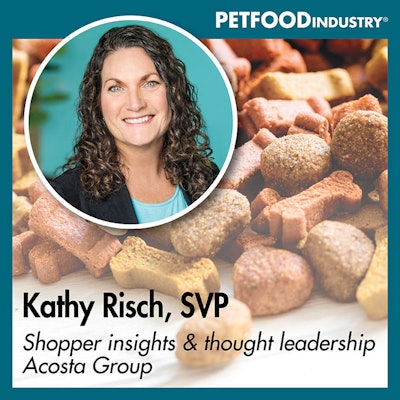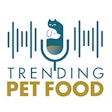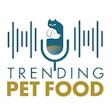
In the latest Trending: Pet Food podcast, host Lindsay Beaton interviews Kathy Risch, senior vice president with Acosta Group, discussing key factors in pet food purchasing, pet parents' views on supplements, and upcoming innovations in the industry.
The below transcript is from Episode 64 of the Trending: Pet Food podcast, where host Lindsay Beaton talks with Kathy Risch, senior vice president with Acosta Group about what is top of mind during the pet food purchasing process, what do pet parents really think about supplements, what innovations do pet owners see coming down the pipeline and much more. You can find the episode at Trending: Pet Food, on SoundCloud or on your favorite podcast platform. This episode originally aired on June 26, 2024.
We want to thank Cargill for sponsoring this podcast. Cargill, a world leader in pet food ingredients and manufacturing, proudly offers TruMune postbiotic. TruMune is made to help modern pet food brands stand out by supporting multiple trending health claims — like gut health, balanced immunity and pet vitality. Best of all? TruMune benefits are packed into a single, low-inclusion ingredient, and it’s backed by several pet-specific research studies.
Lindsay Beaton – editor, Petfood Industry magazine, and host, Trending: Pet Food podcast: Hello, and welcome to Trending: Pet Food, the industry podcast where we cover all the latest hot topics and trends in pet food. I’m your host and editor of Petfood Industry magazine Lindsay Beaton, and I’m here today with Kathy Risch, senior vice president, shopper insights & thought leadership for Acosta Group. Hi Kathy, and welcome!
Kathy Risch, senior vice president, shopper insights & thought leadership for Acosta Group: Hi, Lindsay. I'm happy to be here today and talk about the research we've done.
Beaton: In case you’re not familiar with Kathy or Acosta Group, here’s what you need to know.
Kathy is an accomplished leader with over 25 years of transformative insights experience in consumer goods. With a robust background in market research, analytics, and consumer product innovation, Kathy has held key leadership roles at renowned companies such as P&G, Neutrogena, Paramount Pictures, and Anheuser-Busch InBev.
In her current role, she oversees 30-40 research studies fielded annually through Acosta Group’s proprietary Shopper Community. Kathy's strategic thought leadership and extensive marketing and consumer insights acumen have played a pivotal role in driving growth for major brands across diverse product categories and retailers. Kathy holds an MBA in Marketing from Indiana University and a BA in Economics and Management from Albion College.
Acosta Group is a collective of the most trusted retail, marketing and foodservice agencies empowering brands and retailers to win in the modern marketplace. By delivering transformative, commerce-focused solutions and more than 95 years of expertise, Acosta Group connects brands with people at every point in the consumer journey. Comprised of Acosta, ActionLink, CORE Foodservice, Mosaic and Premium Retail Services, Acosta Group understands and anticipates evolving consumer needs, fueling accelerated performance to connect tomorrow’s commerce today.
Kathy’s extensive experience and insights into all things consumer trends is why I’ve brought her on today to answer this question: What’s going on with pet food customer shopping trends these days?
Are consumers starting to cut back or compromise in their pet food purchases?
Now, I want to dive right in because I know my audience is very much into consumer trends for obvious reasons and is going to want to know as much as possible in the time that we have. Given everything that's going on right now, we're paying more attention than ever to consumer trends. Where are consumers refusing to compromise, even with all the economic factors at play, right now? Because there is a lot going on.
Risch: That's a great question. We really wanted to dive into that answer ourselves. As you mentioned, my team oversees quite a bit of research throughout the year that we're conducting with our shopper community at Acosta Group.
The study I'm going to be referencing today we conducted this year, back in January, among pet parents. We focused on respondents who have dogs and/or cats living in their household doesn't mean they don't have other types of pets, but we really did focus on cats and dogs and trying to understand the aspects of their lives that surround that pet ownership.
We did get a bit into the pet and human connection. That directly links to your question of what the priorities are when it comes to what they're not willing to give up, despite the economic influences and challenges. I have quite a bit of insights around that relationship with the pet and how that directly links to their shopping journey for their pets.
To directly answer your question about what are they refusing to compromise? This is a very interesting topic and answer because they're not willing to give up a lot. The reason is the bond is so strong with their pets. Dogs or cats are a part of their family. Most households do truly believe that the dog or the cat is a part of their family. I mean, we're talking 96% of dog parents and 96% of cat parents believe the pet is a part of their family.
What links directly to that is they're willing to adjust their own budget to afford their pet expenses. The reason why I gave this long-winded explanation is that is one of the highlights of our study and key insights for us is that they are more willing to spend on their pets, and less willing to compromise versus themselves or their family.
Beaton: Is this something that is being seen in other industries? People compare the baby segment to the pet segment a lot, just because in terms of flexibility and willingness to compromise, they're on about the same level these days. Are there any other industries that you've researched where people seem more willing to hold fast than to compromise? Or are those the two big ones where people are like, “No, I will give up other stuff before I compromise on this.”
Risch: That's a great parallel. I don't have the exact percent. For instance, when I mentioned those that are willing to adjust their budget to afford the expenses of their pet, we're talking over eight and 10, are willing to do that. That's quite a majority. I don't have this statistic for baby care.
The interesting thing about the pet category is it's a bit more challenging to trade down to find the right brands, the right products, and be able to make that compromise. I would say the same thing in baby care. Retailers and brands or private label give the opportunity to trade down, to spend less, to shop around, and this is going to make an impact and it becomes more challenging. People are less willing to do that. I think it's a good parallel. Baby care is something that's riskier to switch and change. That's the same thing with pet care. It's riskier to switch or change what you're feeding your pet given some of the concerns that come along with that.
Beaton: Given that we know people do not want to switch around when it comes to a pet, but considering economic instability has been quite the household factor for the last couple of years, are there any places where consumers are starting to cut back?
Risch: The one area they're going to cut back on is where they can lower the price. Pet shoppers are noticing higher prices. This is nothing new in 2024.
We did a pet care study a couple of years ago as well, and we saw the same thing happening. As a matter of fact, the high prices were kicking in back in 2022 when we did that study. Shoppers are telling us in 2024, yes, they're observing higher prices, and they need to be looking for where they can save money. Whether that is trading to a different store where they might find a better price point or to a smaller size package, there is some shifting. They're always on the lookout for a deal, whether that's going to be in a different store or online.
Noticing high prices has been around for several years. Interestingly, I would say the concern for higher prices is moderating a bit. Back in 2022, we did see more people saying they had high concern with prices, and now more of them are saying it's moderate concern. They're still concerned about high prices, I just think they're so used to it by now.
We're seeing the same thing across the whole grocery store. They are continuing to notice it, but it's kind of old news that the price has just continued to keep going up. We do see that same concern for all prices in their lives. The pain isn't going away. It's just that shock factor has dissipated.
What is top of mind for owners when purchasing pet food?
Beaton: I think it's fascinating that there is an exhaustion point with this sort of thing, where if it goes on long enough, consumers are like, “Yep, what are you going to do about it?” Honestly, what are you going to do about it? If you're just the average everyday consumer, you still have to put food on your table, you still have to feed your pets. I find it interesting that that's borne out in the data.
When you do surveys that people are still concerned, but like you said, the shock factor wears off and people are like, “Yeah, I'm concerned, but it has just kind of integrated itself into everyday life at this point.” What are consumers looking for in pet products right now if they're trying to price down, but they're not as concerned as they were? What do we see in terms of actual fluctuations on store shelves with what consumers are willing to pay for?
Risch: In our research, when we were talking with pet parents -- again, when I reference that I'm talking about both dog parents and cat parents because many people think that they're very different -- there's a lot of similarities in how people shop and make decisions. If you're a cat parent, you feel very strongly about cats and the same for dogs. I will try to call out some differences that exist.
Overall, one of the most important areas they're focused on in terms of a pet product is the ingredients. We see what they're doing in terms of pre-shopping behavior. Before they even buy a particular pet food or treat, they're researching. They're looking at what's in the ingredients, the transparency of the ingredients. I can get more into that later but that's a big topic.
Ironically, that's gaining more traction with consumers for regular food and beverage on the human side of the business. There’s a focus on ingredients and transparency of simple, healthy, not bad ingredients. The same thing is going on for pets.
Consumers do find a lot of information online ahead of time, but also just reading the packaging is important. They are focusing on that type of information about the product before buying it -- even more so than comparing prices. Going back to the prices because it supports what I mentioned before -- yes, people are noticing higher prices. But the reason I said there's not a ton of tradeoffs happening is even when they're comparing products, they're more focused on ingredients than price. I can't say that for many categories across the store.
They do this when they're looking at both food and supplements for their pets. Number one, they're very focused on health, the health aspect of the dogs and the cats is a very important thing when it comes to topics they're interested when researching. The top three for dogs are allergies, weight control and digestion. For cats, it's the identical three, just in a bit of a different order. Digestion is number one, weight then allergy.
You've got these health concerns that are top of mind, so when they're doing that product research on what they're interested in, when they're looking for a product that's relevant for them to buy, those are some of the things they're going to focus on.
Some of the qualities that they look for in a product are "high protein” -- always going to be a number one important feature of a product they're looking for. Coming in right at the same level of importance and interest for the ingredients is “fresh” and “minimally processed.”
The other thing I mentioned about health and digestion is probiotics. Gut health continues to get more attention for pet care. One that rises to the top that is interesting is joint care. “Reducing pain and stiffness” had very high interest in appeal on what they're looking for. That's not something you see at the top of the list for human food products. I think that's an interesting one to call out.
Finally, the all-important “natural and organic.” I'm going to give you a heads up about a theme throughout this research which is how similar important things are for them and their pets, particularly food, which parallels and mirrors what is important for themselves and their family.
What do pet parents think of supplements?
Beaton: You have touched on so many hot topics and trends in the last couple of minutes that I know my audience is sitting there going, “oh, please tell me more about this.”
We can't dive into all the subtopics because I try not to keep people on the podcast for two hours, but I want to talk about supplements. It's a very hot segment in the industry right now and still a little bit of the Wild West. People are still trying to figure out if it's worth it to get into with supplement-only companies coming in. There's so much going on right now, and, like you said, it’s all centered around this health and wellness trend that is really dominating the industry. Do you have any more data on the types of supplements or even just some overarching information on what consumers think about pet supplements right now?
Risch: We didn't dive deep into the actual type of supplements in terms of form and how it fits into their lives behaviorally. Our focus was more around what the health concerns are because we were asking about their health concerns that were top-of-mind when they're researching the products for their pet.
We really asked our questions more in the context of overall food and supplements. What we have learned over the last couple of years of doing research among pet parents is that they're focused on these health benefits in both the supplements and the food. They love to get it from their food directly, not just their supplements. The more they can get from their food is great. In this study, we did lump those two categories together.
What trends will play out in the next two to three years?
Beaton: I think it's also very interesting that consumers are looking for that in their foods, because functional is a big trend in the space and something we talk about a lot. Again, that plays into the overall health and wellness trend. It's fascinating that you're seeing so many different facets of that as you're asking people what they care about. Everything through to joint health, which we have recently started conversations around aging pets, and how people are looking more toward longer lifespans and realizing their pets are becoming old men and old women and need some of the same sort of care that we look to in ourselves as we get older.
In terms of all these current trends, how do you think it's going to play into say, medium term in the pet food market? What is the shakeup going to be in the next two to three years?
Risch: While my team isn't forecasting exact numbers, we leave that to other companies in terms of the size of the sales projections in the next couple of years, I will say that overall, what we've witnessed in terms of pet adoption, pet ownership increasing, the most obvious thing is obviously the size of the category is going to continue to grow.
What our insights show are the segments of the category and the products and new innovations that are centered around those health benefits. The better-for-you ingredients are going to be a very strong growth area, not only for consumer interests, but manufacturers are going to be focused on innovation that brings a lot of those benefits.
We did ask the pet parents what they predict for the future. It was a fun exercise to see what they think is going to happen, what the trends are going to be, and touched on innovation and what they'd be interested in, which was fun. We have already seen in our own research where things are heading. As I mentioned, in terms of those health benefits, it's cool that they were able to open their minds to this.
There were many topics I could talk about -- a lot of different things they brought up. If I focus on the top three that were mentioned, in terms of what pet parents predict, they’re in food and nutrition. That’s the obvious one we've been talking about here. There are a lot of different aspects -- more focus on natural, of course. I can go into that a little bit more. On the healthiness of the food there are a few different dimensions there.
Secondly, they predict prices will continue to rise. It's not just “oh, hey, prices are going to continue to rise,” but it's really going to drive up the cost of ownership. This goes across services as well. They understand it's not just about the food, the treats, and the supplements, but the actual cost to care for the pet. It's going to cause hardship. Pet ownership is such an important part of their lives – they’re part of the family, they're not willing to compromise, yet that's going to create hardship. Unfortunately, even pet parents predict that some people will give up their pets. We've already seen a small segment who had to surrender their pets. It’s a sad statistic to share. We see that coming through our research that so many people adopted a pet during the pandemic. I think people are very nervous about that overall financial hardship of owning pets. We have a bit of information about insurance and how that might become more relevant. We see a rising investment, slightly higher level of consumers investing in the insurance to help control that cost.
The last area they're predicting, which is maybe not surprising to your audience, but I think cool in terms of the ways they talked about this, is AI-related technology impacting the entire pet business. There are some cool aspects. While AI is hot everywhere, they really did put a lot of thought into their answers on how technology is going to impact pet products and support the pet relationship and pet lives.
Beaton: For the technology side, was it a lot of app-based things? Or when they say technology, do they mean physical objects like cameras and auto feeders and things like that?
Risch: Yes, yes, and others. Let me give you a few examples. One would be AI that helps the pet owners take care of their pets, meaning if they're so focused on the right food and supplements and care for their pets, there's AI technology that can help them determine genetics and health history -- really guiding them to how to personalize care and products for their pet.
Then, on the other hand, having AI that interacts with their pets when they're home alone -- ways that they can interact with their pets, for example, like a pet camera. I think there's a lot of that already exists. There’s a whole different level of how you might be able to interact with your pet, while they're home alone, and extend that all the way to even robotic pets. I don't exactly know what the consumers are talking about, but perhaps there’s a more affordable pet that doesn't eat but they can have entertainment from a non-human pet.
I thought another interesting area was fitness. Two areas. One is wearable devices for pets, like smart collars that are monitoring activity levels or health metrics, but also giving real-time data to pet owners. There are already GPS systems that exist that you can attach to a pet for safety reasons. I think these ideas, we're taking it to a whole new interesting level of engagement for pet owners.
What do consumers expect from pet food in the future?
Beaton: Can you go a little bit more into the pet foods specific things that pet parents honed in on when you ask them about the future?
Risch: Yes, absolutely. Based on what I said earlier, one might have expected they would just talk about healthier ingredients. They absolutely did talk about that as well as how that trend would be even more toward natural and organic ingredients than ever before. They did, however, add a layer of freshness in that they expect more fresh pet food will continue to flood the market, even more refrigerated brands.
On the other side, they talked about the newest rage being freeze-dried pet food. That was interesting to us, because so much of the focus is typically on that fresh, refrigerated trend. I like to say there is always a counter trend to every trend. Both are interesting to understand. The freeze-dried trend is interesting in terms of convenience and value, because you can store it for a long time and it can still taste great.
Lastly, the focus was not just around higher quality ingredients but things like flavors and textures that can be more interesting. I loved this because they took it to the extent of making mealtime more interesting to the pet. Think about experiences and the human side and how experiences are a big part of what people like to focus more on and get more fulfilling experiences. I think it's interesting that pet parents think the meal experience will become more of a focus.
What’s the best way to communicate with pet parents?
Beaton: You have touched on so many topics that go around the industry in terms of connecting with the consumer packaging and the trials and tribulations of pet ownership. There are pet food companies out there trying to work with pet owners the best way they can to help them understand what kind of food they should be feeding their pet and how they can keep their pets healthy -- pet obesity is a big problem.
Companies have blogs, they do podcasts, they try to gorilla market straight to consumers, and they're on social media. We're about halfway through 2024 which means companies are starting to look toward 2025. If the pet food industry really wants to connect with their consumer, what should they be focusing on? Is it the more impersonal -- make sure our packaging is top notch -- or should they really be trying to make a personal connection with their consumers as much as you can as a business?
Risch: What pops in my mind immediately is feedback that in addition to this research that we did in the survey, we at Acosta Group also have a lot of pet ambassadors in the field that are in stores every day. I interviewed them and really tried to understand what some of the opportunities are for manufacturers and retailers. Pet parents and shoppers need help. They need help finding the right products for their pets. That is the most obvious, low hanging fruit is to help them get there. That’s why, yes, it's going to be what's on the packaging.
If you can communicate as simply but effectively as possible on your packaging, that's going to be critically important to them understanding if the ingredients and the benefits are relevant to their pet and health concerns. Packaging will help them in terms of high-quality ingredients explained on the package, as well as help retailers playing a role in that help in the store. When people are looking for help from people, they prefer to ask someone. Having well-trained staff in stores is a preference.
For someone that's making a trip to a store, particularly pet specialty, they're expecting someone to be able to provide that advice. From our study, we know the number one place they get advice and trust is it going to be their vet. However, in a store, they really do appreciate the kind of help. With the labor challenges that continue to exist, for retailers that are challenged, make it easy then to find the products and the information through a very well-organized assortment and store design, signage and display.
There are some really great examples of displays and helpful information to get to that information out before the consumer even gets to picking up a package and looking at what's on the pack.
The last point would be the out-of-store, which yes, you mentioned social media. Social media platforms are becoming more and more influential. Our respondents in the survey talked about that. There are online platforms that are specializing more in pet. Pet owners are posting videos on TikTok, but manufacturers and retailers can play a part of that as well. There are many ways to connect.
The last piece would be that experiential, such as holding events. Whether you're a pet retailer or a traditional retailer, you can hold relevant events for your pet consumers where the pets are a participant, or you're allowed to bring your pet -- it's all around the pet. The relationship with your customer, who's a pet owner too, is well understood. This extends into food service as well, where more and more restaurants are allowing pets and providing pet-relevant items on the menu. There’s more I could continue to talk about, but those are some of the ones that popped in my head.
Is brand loyalty still important to pet parents?
Beaton: Was there anything in the data that -- given you did this in 2022 as well -- was there anything that surprised you about the 2024 results?
Risch: For me, the most surprising part was what we talked about in the beginning -- their unwillingness to compromise. We're seeing so much compromise on the human side of the business when you look across the store at all groceries and household needs of how much people are trading down, making sacrifices to at least try and adopt -- shop at different stores, buy private label over brand name. To see how much brand loyalty and importance of brand and ingredients -- less trading down and less willing to compromise, was a surprise. I expected by this point, they would be behaving like everything you see in the news about private label. Maybe it could be that there isn't as much private label or trading out or trading down opportunity. I will say our research supported this. Almost six in 10, their final purchase decision is influenced by the brand they previously purchased; secondly, nutrition and ingredient information, and a distant third is an in-store discount or deal. You don't see that on the regular food, beverage, household need side of the business. I think that was most surprising.
Beaton: I would agree. Brand loyalty has been on a downswing overall in consumer goods for a while. To hear 60% of pet owners are still feeling brand loyal? Even in a market that's so mature with so many options and clear economic factors that are making them trade down in other areas.
I think it really says something about pet owners and the pet food industry that the willingness is still there after everything that's been going on the last couple of years.
Risch: Just recently, I was part of a webinar we lead at Acosta Group about why brand names still matter. One of the points brought up was how it does vary greatly by category. That’s where this study really hit home on how much brand name is such a heavy factor – it’s the number one factor of importance when making their final decision to buy.
Beaton: We have touched on a lot of consumer data and a lot of consumer trends. To wrap up, I want to know, is there was one piece of information or piece of advice you think the audience listening right now should take away from this? They listen to the podcast, maybe they forwarded on to their coworkers, but maybe they're talking around the virtual water cooler, and saying, “Hey, I just listened to this podcast.” What should the topic of conversation be? What should their main takeaway be from this survey that you did?
Risch: People need, want and love pets in their lives. They are part of the family, and they're not willing to compromise. They want to care for the pet as best as they can, but they're struggling financially.
How can we as an industry continue to help versus hurt that situation in that pain? The more we can provide information and get them to the information to help their pet, as I mentioned, to help them along that journey, that shopper journey, to find the product that is going to be best for their pet. They are willing to pay, but don't selfishly take advantage of that and continue to raise prices and reduce pack size in a selfish way.
That is another one of the biggest things that was called out – shrinkflation. The pet owners notice it, and they are afraid it's going to continue. Avoid that and focus more on how to help pet owners continue to afford owning a pet and taking care of them so that they don't have to get rid of their pet or surrender their pet.
Beaton: Thank you, Kathy for being on today. This is all incredibly relevant information and incredibly useful and very interesting. Unsurprisingly, anything having to do with consumer trends is an ongoing hot topic in the industry right now. With so much going on economically, it's more important than ever, to stay on top of things in order to continue to be successful. Before we go, I want to do a little plug, where can people find more information about you and Acosta Group?
Risch: Acosta Group has several social media channels if you want to check us out. We are on LinkedIn and Instagram. Our website, acosta.group, is the greatest resource for any information about what we do as a company and all the various services we provide across the retail industry -- for sales and marketing and the consumer insights piece that I've been talking about today. We're doing studies throughout the year, so anyone that wants more information about this study, or wants more information about any of our other research we've conducted throughout the year, email us at [email protected].
Beaton: Excellent. That's it for this episode of Trending: Pet Food. You can find us on petfoodindustry.com, SoundCloud or your favorite podcast platform. You can also follow us on Instagram @trendingpetfoodpodcast. And if you want to chat or have any feedback, I'd love to hear from you. Feel free to drop me an email: [email protected].
And of course, thanks again to our sponsor, Cargill. This world leader in pet food ingredients and manufacturing proudly offers TruMune postbiotic. TruMune is made to help modern pet food brands stand out by supporting multiple trending health claims — like gut health, balanced immunity and pet vitality. Best of all? TruMune benefits are packed into a single low-inclusion ingredient, and it’s backed by several pet-specific research studies.
Once again, I'm Lindsay Beaton, your host and editor of Petfood Industry magazine, and we'll talk to you next time. Thanks for tuning in!


















